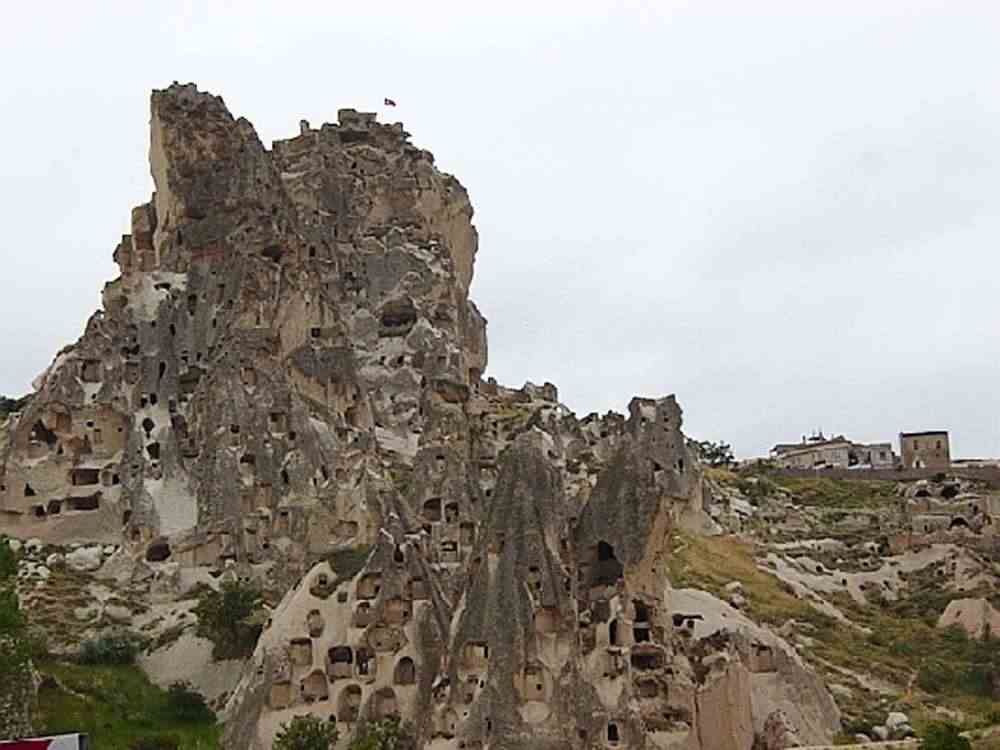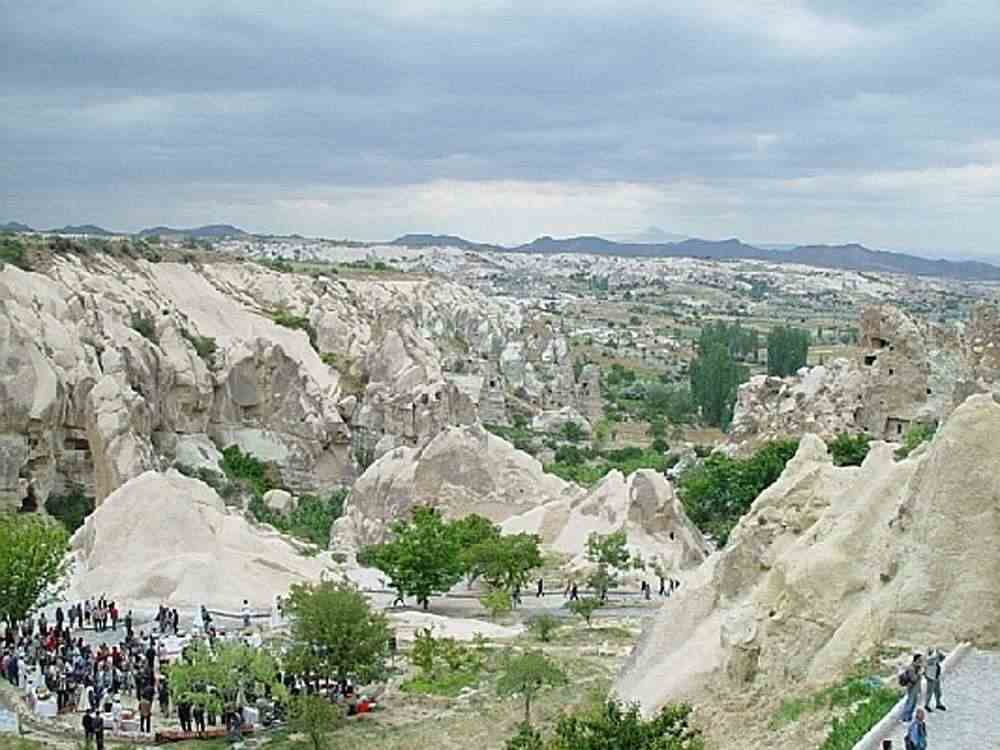On our 54-day around-the-world tour in 2002 we visited Cappadocia during our 2-week tour of Turkey.
Cappadocia was the highlight of our tour of Turkey.
It is fantastically different and is one of those places that you must see at least once in your lifetime.
Two ancient volcanoes, Hasan Dagi and
Erciyes Dagi, mark the western and eastern boundaries of a region known
for its curious volcanic landscape
that has been relentlessly carved by nature and by the people who have
lived here.
'Fairy chimneys', cones and strange rock formations have been sculpted
by wind and rain while subterranean towns were excavated
by a populace seeking shelter from the conquerors and
would-be conquerors who crisscrossed the wide open steppes of the
Central Anatolian Plateau.
Ancient Anatolian tribes, Assyrians,
Hittites, Phrygians, Turkic tribes from Central Asia, Mongols,
Persians, Syrians, Arabs, Kurds, Armenians, Slavs, Greeks,
Romans and Western Europeans have all passed through leaving behind
some of their traditions as well as their genes
and rendering Cappadocians as exotic as their surreal surroundings.
Eruptions fom volcanoes spread a thick layer of hot volcanic ash over the region which hardened into a soft, porous stone called tufa.
Over aeons of geological time wind, water and sand erosion wore away portions of the tufa, carving it into elaborate and unearthly shapes. Boulders of hard stone, caught in the tufa and then exposed by erosion, protect the tufa directly beneath from further erosion.
The result is a column or cone of tufa with a boulder perched on top, whimsically called peribaca or fairy chimney.
Entire valleys were filled with these formations, many of them amusingly phallic in appearance.
At
the top of the high plateau. uchisar looks like a majestic fortress,
with myriad holes & openings on its façade, which
are due to former collapses.
This used to be the most populated area of the settlement. However, as
the population increased and the danger caused by erosion became
greater, people moved away.

The rock is soft enough to carve out for buildings but hard
enough not to crumble.
We visited a house that had 6 floors carved out. It was comfortably
fitted out with Turkish carpets.
Hollows
had been carved into the walls for shelving.
Goreme open air museum.
Early Christians carved
chambers, vaults and labyrinths for use as churches, stables and homes.
There were painted church murals in the
former rock-hewn monastery, nunnery and several churches.

Goreme
is one of the oldest settlements of the region. Especially during the
expansion period of Islam,
this small town was occupied by the Christians who were under attack by
the Arabic Muslim conquerers.
Some of the earliest churches in this area date back to the 7th century
A.D. St.Basil, from Kayseri,
established the first monastry in Goreme to educate missionaries.
Some murals date from as early as the 8th century, though the best are from the 10th to the 13th centuries.
Kaymakli,
one of the underground cities.
The city is estimated to be occupied since the
5th century B.C.
During the following ages, it is known to be used by the Christians as
a refuge against the Arab aggressors.
They
had a central air shaft that was a well in the bottom floors.
9 floors have been cleared so far. We went down 50 metres.
The city was sub-divided into separate sections for better defense
purposes.
The corridors were very narrow. But the living rooms, meeting halls,
churches and other facilities were very comfortable.
The
storage rooms were capable of storing enough food for the residents for
many months.
The air shafts and water wells were adequate for 15,000 people, living
all together for a very long time.
Each section could be isolated from each other by closing the
mill-stone shaped round rock gates with a diameter of 1.5m.
They had
secret tunnels to watch the enemy.

A police station hewn out of the rock.
The tufa was easily worked with primative tools and the inhabitants
learned early that sturdy dwellings could be cut from it with a minimum
of fuss.
A cave could be carved out
very quickly and, if the family expanded, more easy carving could
produce a nursery or storeroom in next to no time.
Aeons worth of volcanic eruptions dumped layers of mud,ash,and
lava on the area. Eventually these layers compressd and turned into
tufa, a soft, porous rock.
Erosion by rain,snow, and wind created a fantastic relief of rock
formations resembling chimneys, cones, needles, pillars and
pyramids,
often topped by perfectly balanced gigantic slabs of rock.
Then
came earthquakes to add vast valleys and oxidation to give the area the
final artistic touch: rocks "painted" yellow, pink, red, russet and
grey-violet.
We visited a carpet "factory" for an excellent demonstration
of carpet weaving.
Double and single knots were explained. Double knots are exclusively
Turkish.
We also
saw a demonstration of the extraction of silk thread from silkworms.
The ruins of an old caravanserai (Tepesidellis) on the Old
Silk Road that started in China and ended at either Ephesus or Istanbul.
Serai
means place for caravans.
Mt. Arsan
Agzikarahn
Caravanserai
A typical caravanserai which operated on the Arksaray Kayseri Highway
(part of The Old Silk Road).
It has two parts, one opened and one covered, which are used for summer
and winter time. It dates from 1231.
Besides
sleeping quarters, a mosque and stables, there would have been shops
and trading areas.
We went to a Whirling Dervishes performance at Sarihan Caravanserai.
Serais were the "motels" for the caravans along the Silk road which ran from China to Ephesus or Istanbul.
People could stay for free for 3 days but there was a tax on the extensive trade that took place within.
Whirling Dervishes performance at Sarihan Caravanserai.
Dervish sects began appearing in Islamic countries from the 9th century.
The Whirling Dervishes order is based on the philosophies of
Mevlana Rumi (1207-1273).
It has principles of universal love and the oneness of creation, which
states "to love man is to love God".
The ritual takes the form of the sema, a ritual whirling dance whose
purpose is to create a sphere of divine reality.
They had
leather slippers to make it easier to spin on their own axis and white
skirts with corded hems to make them spin out.